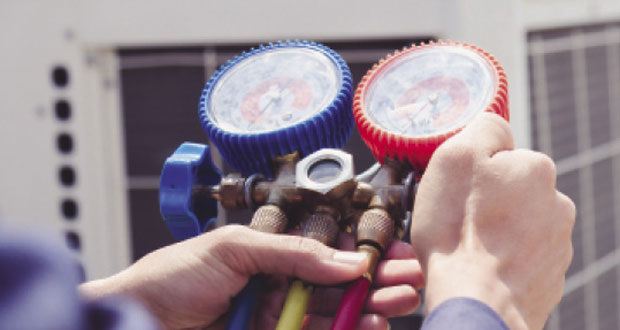 Despite its huge benefits, refrigerant gas used in HVAC does come with inherent risks. Shaun Evers, Managing Director of Stonegate Instruments, discusses possible leak causes, what to look out for and the clear benefits associated with the latest technology
Despite its huge benefits, refrigerant gas used in HVAC does come with inherent risks. Shaun Evers, Managing Director of Stonegate Instruments, discusses possible leak causes, what to look out for and the clear benefits associated with the latest technology
Refrigerant gas is one of the most overlooked parts of any air conditioning system. If your system is not cooling your room as well as it used to or if your evaporator coils are suddenly covered in ice, it’s most likely because your unit is leaking gas.
Air conditioning units now use R32 coolants, since R22 ones were banned in the UK. Despite R32’s high efficiency in HVAC systems and its low GWP (Global Warming Potential) they are still composed of chlorofluorocarbons that pose several dangers to human life. Therefore, effort must be made to understand the dangers, the possible causes, remedies and technology to support the safe use of these systems.
UNDERSTANDING THE DANGERS
The loss of refrigerant gas can cause your system to cool inefficiently and struggle to produce adequate air conditioning, not to mention the irreversible damage to your machine’s compressor and to the health of your employees.
As coolant leaks from your system it rapidly evaporates into a lethal gas which can cause asphyxiation. More commonly, it can cause difficulty breathing, headaches, nausea and vomiting, skin and eye irritation, and coughing. If exposure to the gas is prolonged it can lead to other life-threatening medical conditions.
During a leak your system is working harder to compensate which in turn increases electricity consumption and your monthly energy bills. According to several studies, a leaking air conditioning unit consumes almost 20 per cent more electricity than a fully functioning one.
To put that into context, it has been suggested that a small continuous leak, left unrepaired for three months, could use an extra 10kW in electricity – equivalent to approximately £1,400 in energy bills – once the leak becomes critical.
LEGALISATION AND COMPLIANCY
In early 2020 the European Commission brought in fluorinated gas (F-gas) regulations as part of a policy to combat climate change. The plan is to phase down the CO2 equivalent emissions from hydrofluorocarbons (HFCs) by 79 per cent (relative to 2015) by 2030. As the UK has now left the EU, the UK government has specified that businesses will have to apply for a new GB HFC quota while they follow the same CO2 phase down as was specified by the European Commission. As HVAC and refrigeration manufacturers commit to developing environmentally compliant products without compromising on performance they are also seeking to address health and safety concerns.
These regulations place a greater focus on carrying out regular gas leak checks on systems. Operators of stationary equipment, heat pumps and air conditioners that contain F-gases in quantities of 5 tonnes CO2 equivalent, or more, must ensure that equipment is routinely monitored. For apparatus without gas leak detection installed, the period between mandatory gas leak checks obviously lessens.
RECOGNISING THE SOURCE
Continually using an air conditioning system, even after a leak has developed, can put excessive pressure on the compressor and other components. The compressor can break and cost significantly more to replace than the cost of identifying the leak earlier on and repairing it.
Probably one of the most common leak causes is corrosion. It is a factor that has plagued the HVAC industry for many years due to the exposure to fluorides and chloride in water supplies and cleaning chemicals. Another common cause is poorly connected control valves or connectors that have not been cleaned properly before joining. Similarly, poorly soldered fittings can easily lead to a refrigerant gas leak.
It is also worth noting that mechanical damage can be a cause. The refrigerant lines in your system move the gas between the evaporator and condenser. As you may expect, refrigerant lines passing through the exterior of the unit are particularly susceptible to damage, resulting in a leak.
WORKING WITH TECHNOLOGY
Nothing can replace the accuracy and efficiency of using technology to identify a gas leak, however there are a few simple things to look out for if you suspect a leak.
If you suspect your unit is not working properly check for the pungent smell of the gas. The leak may not be in the same room as the main unit so you would have to check the whole system. Also checking all pipes for stains and listening for a ‘humming’ sound coming from your thermostat pipe are other basic checks that can be done.
These checks are time consuming and fraught with human error. The person checking may not check all the pipes, they may have impaired hearing or sense of smell resulting in it not getting detected, the leak getting worse and having drastic results.
For facilities managers, self-contained single fixed gas sensors, which are more suited to target R32 gases associated mostly with HVAC units, are quickly becoming commonplace. The clear benefits of detection sensor technology are why some leading detection systems on the market have a proven return-on-investment of just two years, and that is without taking into consideration the cost of repairs to an existing faulty system. As well as leak detectors, sophisticated refrigerant sensor equipment is available with signalling alarms, LED lights that indicate the presence and status of each sensor and also audio/visual alarms to alert staff.
As awareness of the dangers of leaks and benefits of market leading technology circulates further among facilities managers, and as businesses become more accountable in regards to health and safety, utilising the latest detection and alert technology is paramount.





